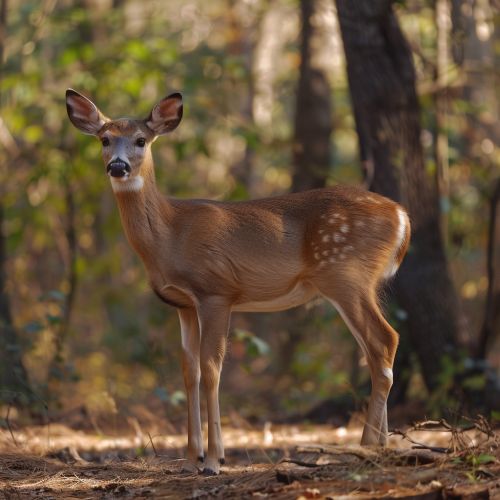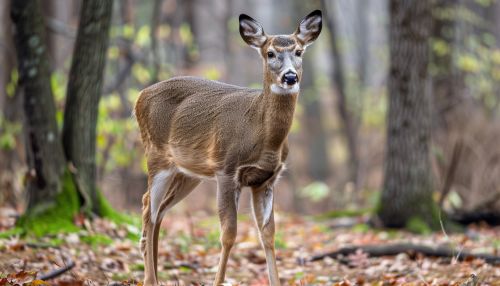White-tailed deer
Description
The White-tailed deer (Odocoileus virginianus), also known as the Virginia deer or simply as the whitetail, is a medium-sized deer native to North America, Central America, and South America. The species is characterized by the white underside of its tail, which it raises as a signal of alarm. This species is highly adaptable and can be found in a variety of habitats, including forests, grasslands, and even urban areas.


Taxonomy and Evolution
The white-tailed deer belongs to the family Cervidae, which includes other deer species such as the moose and the elk. The genus Odocoileus also includes the mule deer (Odocoileus hemionus). The species was first described by Carl Linnaeus in 1758. Genetic studies suggest that the white-tailed deer diverged from its closest relatives around 4-5 million years ago.
Physical Characteristics
White-tailed deer exhibit significant sexual dimorphism, with males (bucks) being larger than females (does). Bucks typically weigh between 150-300 pounds, while does weigh between 90-200 pounds. The coat of the white-tailed deer changes with the seasons, being reddish-brown in the summer and grayish-brown in the winter. The most distinctive feature is the white underside of the tail, which is used as a signaling mechanism.
Antlers
Only males grow antlers, which are shed and regrown annually. The antlers are made of bone and can grow up to 1 inch per day during the peak growth period. The size and complexity of the antlers are influenced by age, nutrition, and genetics. Antlers are used primarily during the rutting season for combat with other males.
Habitat and Distribution
White-tailed deer are highly adaptable and can be found in a variety of habitats, including deciduous forests, grasslands, and wetlands. They are also increasingly found in suburban and urban areas. The species is distributed from southern Canada through the United States and Mexico, and as far south as Peru and Bolivia.
Behavior
White-tailed deer are primarily crepuscular, being most active during dawn and dusk. They are social animals and often form small groups, especially during the winter months. The species is known for its agility and speed, capable of running up to 30 miles per hour and leaping over obstacles up to 8 feet high.
Communication
White-tailed deer communicate through a variety of vocalizations, body postures, and scent markings. The most well-known signal is the raising of the white tail, which serves as a warning to other deer. Bucks also use their antlers to mark trees and shrubs, leaving both visual and olfactory signals.
Diet
White-tailed deer are herbivores and have a diverse diet that includes leaves, twigs, fruits, and nuts. They are also known to consume agricultural crops, which can lead to conflicts with humans. The diet varies seasonally, with a preference for high-energy foods such as acorns in the fall and winter.
Reproduction
The breeding season, or rut, occurs in the fall, typically from October to December. During this time, bucks become more aggressive and compete for access to does. After a gestation period of about 200 days, does give birth to one to three fawns in the spring. Fawns are born with a spotted coat, which provides camouflage.
Predators and Threats
White-tailed deer have a variety of natural predators, including wolves, coyotes, and bobcats. Human activities, such as hunting and habitat destruction, also pose significant threats. However, the species is highly resilient and has a strong capacity for population recovery.
Conservation
The white-tailed deer is not currently considered endangered. In fact, in many areas, populations have rebounded to the point of overabundance, leading to ecological imbalances. Management strategies include regulated hunting, habitat modification, and fertility control.
